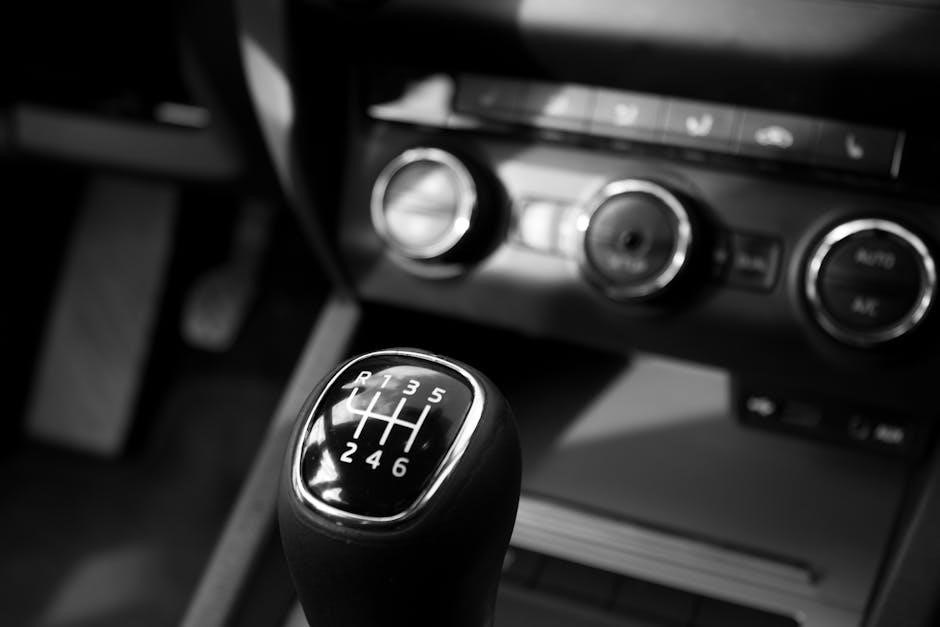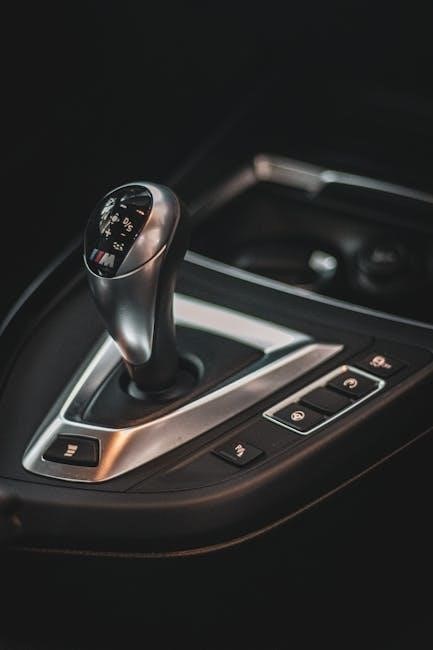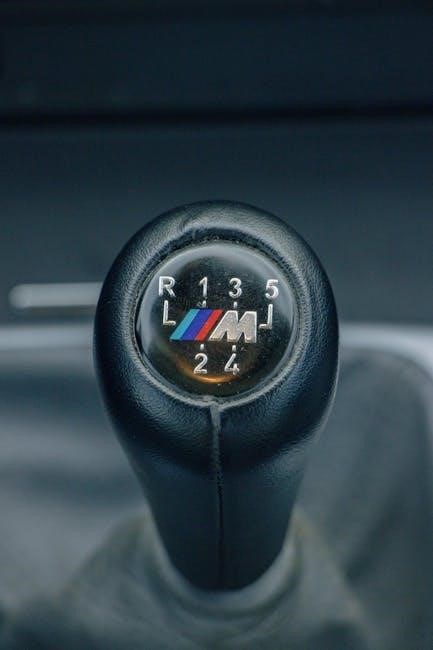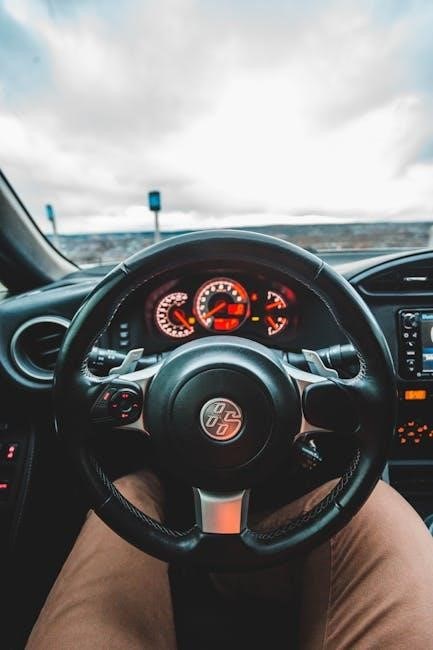Learning to drive a manual transmission car offers a sense of control and connection to the vehicle. It requires mastering the clutch, gearshift, and accelerator. While automatic cars are increasingly popular, many drivers still value the skill and versatility of manual driving. This guide provides insights, tips, and strategies for mastering manual transmission driving lessons effectively, helping you become a confident and skilled driver.
1.1 Why Learn to Drive a Manual Transmission Car?
Learning to drive a manual transmission car offers increased flexibility, as it allows you to operate both manual and automatic vehicles. It enhances driving skills, providing better control and connection to the car. Additionally, manual cars are often more fuel-efficient and cost-effective, making them a practical choice for many drivers worldwide.
Mastery of a manual license offers numerous advantages, including increased flexibility in vehicle choice and improved driving skills. It allows drivers to operate both manual and automatic cars, making it a valuable skill. Additionally, manual driving enhances control and connection to the vehicle, leading to a more engaging and efficient driving experience overall. Mastering manual transmission involves understanding controls, starting smoothly, shifting gears seamlessly, and practicing in various driving conditions. Consistent practice ensures skill development and confidence behind the wheel. Mastering the clutch, gearshift, and accelerator is essential for manual driving. The clutch disconnects the engine from the wheels, allowing smooth gear changes. The gearshift selects the appropriate gear, while the accelerator controls speed. Proper coordination of these components ensures seamless driving and prevents stalling. Practice their operation to build muscle memory and confidence. Starting and stopping safely requires precise coordination. Press the clutch fully, shift to first gear, and slowly release the clutch while pressing the accelerator. When stopping, downshift before coming to a halt to avoid jerking. Always use the parking brake on an incline. Practice these steps to ensure smooth and controlled starts and stops, reducing the risk of stalling or losing control. Mastering first gear and reversing is crucial. Press the clutch fully, shift into first gear, and release slowly while accelerating gently. For reversing, check surroundings, shift into reverse, and release the clutch gradually. Practice these maneuvers in a safe, open space to build confidence and control when moving forward or backward smoothly. Practice shifting gears in various scenarios, such as uphill, downhill, city traffic, and highways. Start with low-speed maneuvers, gradually increasing complexity. Focus on smooth transitions, using the clutch and accelerator in harmony. Regular practice in diverse conditions enhances coordination and adaptability, preparing you for real-world driving challenges and ensuring confident gear changes in any situation. Mastering manual transmission can be challenging, with common issues like stalling, coordinating clutch and accelerator, and smooth gear transitions. Consistent practice is essential to overcome these hurdles and build confidence behind the wheel. Beginners often struggle with coordinating the clutch and accelerator, leading to frequent stalling. Smooth gear transitions and mastering the “biting point” can be frustrating. Additionally, the physical effort required to press the clutch repeatedly and the mental focus needed to shift gears while navigating traffic can be overwhelming for new learners. Consistent practice is key to overcoming these challenges and building muscle memory. Fear of stalling is common among new manual learners. It’s important to understand that stalling is a normal part of the learning process. Practicing in a safe, open space and gradually building confidence helps ease this anxiety. Remember, stalling doesn’t mean failure—it’s a step toward mastering control. Patience and consistent practice are key to overcoming this fear and improving your skills. Manual lessons can be cost-effective, as they often cost less than automatic lessons. While they may require more time to master, the long-term benefits and savings make them worthwhile. Manual lessons are often more affordable than automatic ones due to lower demand. Private instructors may charge slightly more for manual training, but many driving schools offer competitive rates. While automatic lessons are quicker, manual lessons provide better value in the long run, especially for those seeking versatility in driving skills. Mastering manual transmission typically requires 1 to 3 months of consistent practice. Beginners can expect to spend several weeks coordinating clutch and accelerator movements. Regular lessons, such as 90-minute sessions weekly, accelerate progress. Dedication and frequency of practice significantly influence the learning speed, ensuring smooth gear shifts and confident driving. Manual transmission cars face declining demand due to automatic and autonomous vehicles, yet they remain popular among driving enthusiasts who value control and tradition. The shift towards automatic and autonomous vehicles is reshaping the automotive industry. With advancements in technology, automatic cars offer convenience, while autonomous vehicles promise enhanced safety and efficiency. This trend raises questions about the relevance of manual driving skills, as many predict a future where manual transmissions may become obsolete in mainstream use. Despite the rise of automatic and autonomous vehicles, learning manual transmission remains valuable. It offers better control, cost savings, and flexibility in choosing vehicles. Many drivers find manual driving more engaging and rewarding, making it a skill worth mastering, even as technology advances. It also prepares you for driving older or specialized cars. Selecting a qualified instructor is crucial for mastering manual driving. Look for schools like Ann’s Driving School or Stick Shift Driving Academy, known for experienced staff and tailored lessons. Ann’s Driving School and Stick Shift Driving Academy are highly recommended for manual lessons. These schools offer experienced instructors and tailored programs. Monkey Moto and Fun Drivings Cool also provide specialized training. Look for schools with certified educators and positive reviews to ensure quality instruction and effective learning experiences. Ensure the instructor has extensive experience teaching manual driving and is certified. Look for patient, knowledgeable educators who provide structured lessons. Check reviews for feedback on their teaching style and success rates. They should use suitable training vehicles and offer clear explanations of shifting and clutch control to build confidence and skill effectively. Consistent practice in a safe, empty area helps build muscle memory. Start with slow speeds and gradually increase as comfort grows. Schedule regular lessons to maintain progress and refine skills effectively. Empty parking lots and quiet streets are ideal for mastering clutch control and gear shifts. Gradually move to low-traffic areas to practice acceleration and braking smoothly. Avoid busy roads initially to reduce stress and focus on technique. Consistent practice in these settings builds confidence and prepares you for various driving scenarios effectively. Consistency is key to mastering manual driving. Schedule regular lessons, ideally 90-minute or 2-hour sessions, to allow ample time for practice and feedback. Weekly lessons ensure steady progress, while spacing them appropriately prevents overload. Varying practice times (morning, evening) helps adapt to different driving conditions, enhancing overall skill development and confidence behind the wheel effectively. Common mistakes include riding the clutch, sudden acceleration, and forgetting the handbrake on inclines. These errors can damage the car and hinder progress. Awareness and practice help minimize them, ensuring smoother and safer manual driving experiences overall. Common rookie mistakes include riding the clutch, causing wear and tear, and shifting gears too quickly, leading to jerky movements. Forgetting to press the clutch fully before shifting can grind gears. Sudden acceleration without proper gear alignment is another error. Practicing smooth transitions and using the parking brake on inclines helps avoid these issues, ensuring safer and more controlled driving experiences for learners. Maintaining control in varying road conditions requires adjusting speed and gear usage. On wet or icy roads, avoid sudden acceleration and use higher gears for better traction. When climbing hills, shift to a lower gear before ascending to prevent stalling. On descents, use lower gears to control speed without over-relying on brakes. Practice these techniques to ensure safety and smooth driving in all conditions. A manual license offers increased flexibility, allowing drivers to operate both manual and automatic vehicles. It enhances driving skills, providing better control and connection to the car. Obtaining a manual license significantly broadens your options when choosing a vehicle. It allows you to drive both manual and automatic cars, providing more freedom and versatility. This flexibility is particularly useful when renting cars or purchasing second-hand vehicles, where manual transmissions are often more affordable and widely available. Additionally, it opens up opportunities to drive specialized or performance vehicles that typically come with manual gearboxes. Mastering a manual transmission enhances your driving skills by requiring active engagement with the vehicle. It improves control, especially in challenging conditions like hills or heavy traffic. Manual driving fosters situational awareness and teaches you to anticipate and react, making you a more attentive and responsive driver overall. This skillset translates to better handling of all types of vehicles. Technology enhances manual driving lessons through AI and machine learning, providing interactive simulations and real-time feedback. Modern cars feature systems that simplify clutch control, making learning easier. Modern cars incorporate features like clutch-by-wire systems, lightweight pedals, and assistive technologies to reduce stalling; These innovations make manual driving smoother and more accessible, especially for beginners, while maintaining the joy of control. Additionally, gear shift indicators and auto-blip technologies further simplify the learning process, helping drivers master techniques faster and with more confidence. AI and machine learning are revolutionizing manual transmission driving lessons by offering personalized simulations and real-time feedback. These technologies create adaptive learning tools, helping drivers master clutch control and gear shifting. AI-driven systems can predict and correct common mistakes, making the learning process more efficient and reducing the risk of stalling or improper gear changes. Mastering manual transmission driving offers lasting benefits, including better control and versatility. Despite the rise of automatics, learning manual remains a valuable skill for any aspiring driver. Persisting through challenges, manual transmission driving offers a rewarding sense of control and versatility. While automatics dominate, mastering manual remains a valuable skill, providing a deeper connection to driving. The satisfaction of smoothly shifting gears and handling various road conditions makes the effort worthwhile. Embrace the process, stay persistent, and enjoy the freedom it brings to your driving journey. Embrace the journey of mastering manual transmission—it’s incredibly rewarding! While it may seem challenging at first, the sense of accomplishment and control you’ll gain is unmatched. Stay persistent, practice regularly, and remember that every stall is a step closer to proficiency. The freedom to drive any car and the enhanced driving experience make the effort truly worthwhile. Keep going—you’ve got this!1.2 Benefits of Mastering a Manual License
Key Steps to Learning Manual Transmission
2.1 Understanding the Basic Controls (Clutch, Gearshift, Accelerator)
2.2 Starting and Stopping the Vehicle Safely


2.3 Smoothly Engaging First Gear and Reversing
2.4 Practicing Shifting Gears in Different Driving Scenarios
Challenges of Learning Manual Transmission
3.1 Common Difficulties Faced by Beginners
3.2 Overcoming the Fear of Stalling the Car
Cost and Time Efficiency of Manual Lessons
4.1 Comparing the Cost of Manual vs. Automatic Lessons
4.2 How Long It Takes to Learn Manual Transmission
The Future of Manual Transmission Cars
5.1 The Rise of Automatic and Autonomous Vehicles
5.2 Is Learning Manual Still Worthwhile?
Finding the Right Driving Instructor
6.1 Top-Rated Driving Schools for Manual Lessons
6.2 What to Look for in a Manual Transmission Instructor
Tips for Effective Practice
7.1 Best Locations for Practicing Manual Driving
7.2 Scheduling Lessons for Maximum Progress
Common Mistakes to Avoid
8.1 Avoiding Rookie Errors While Shifting Gears
8.2 Maintaining Control in Different Road Conditions
Advantages of a Manual License
9.1 Increased Flexibility in Vehicle Choice
9.2 Improved Driving Skills and Control
The Role of Technology in Manual Driving
10.1 How Modern Cars Are Making Manual Easier

10.2 The Impact of AI and Machine Learning on Driving Lessons
11.1 Final Thoughts on Mastering Manual Transmission

11.2 Encouragement for Aspiring Manual Drivers
